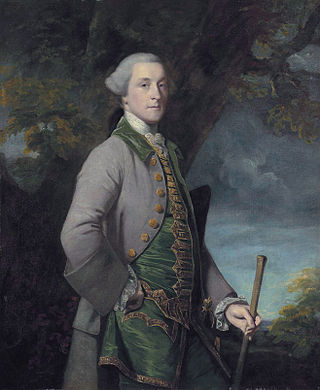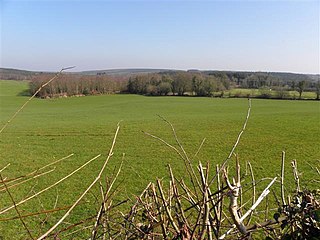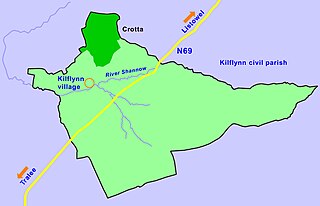
Kilflynn is a village and a civil parish in north County Kerry, Ireland. It is 11 km north-east of Tralee just off the N69 road from Tralee to Listowel.
Earl of Glandore, in the County of Kerry, was a title in the Peerage of Ireland. It was created in 1776 for the Irish politician William Crosbie, 2nd Baron Brandon.
Richard Crosbie (1755–1824) was the first Irishman to make a manned flight. He flew in a hydrogen air balloon from Ranelagh, on Dublin's southside to Clontarf, on Dublin's northside on 19 January 1785 at the age of 30. His aerial achievement occurred just 14 months after the first-ever manned balloon flight by the Montgolfier Brothers in France and is commemorated by a memorial located at the site of this historic event & commissioned by Dublin City Council.

Rowland Ponsonby Blennerhassett KC, JP was an Irish politician.

Richard Boyle, 2nd Earl of Shannon KP, PC (Ire), was an Irish peer and Member of Parliament. He represented Dungarvan and County Cork, and succeeded his father as Earl of Shannon.

Charles Coote, 1st Earl of Bellomont KB PC(I), was an Irish peer. He held a senior political position as one of the joint Postmasters General of Ireland. Charles was briefly styled as The 5th Baron Coote between February 1766 and his elevation to the earldom in September 1767.
Denis Bowes Daly PC, was an Irish politician.
William Crosbie, 1st Earl of Glandore, known as The Lord Brandon between 1762 and 1771 and as The Viscount Crosbie between 1771 and 1776, was an Irish politician.
The High Sheriff of Wicklow was the British Crown's judicial representative in County Wicklow, Ireland from Wicklow's formation in 1606 until 1922, when the office was abolished in the new Free State and replaced by the office of Wicklow County Sheriff. The sheriff had judicial, electoral, ceremonial and administrative functions and executed High Court Writs. In 1908, an Order in Council made the Lord-Lieutenant the Sovereign's prime representative in a county and reduced the High Sheriff's precedence. However the sheriff retained his responsibilities for the preservation of law and order in the county. The usual procedure for appointing the sheriff from 1660 onwards was that three persons were nominated at the beginning of each year from the county and the Lord Lieutenant then appointed his choice as High Sheriff for the remainder of the year. Often the other nominees were appointed as under-sheriffs. Sometimes a sheriff did not fulfil his entire term through death or other event and another sheriff was then appointed for the remainder of the year. The dates given hereunder are the dates of appointment. All addresses are in County Wicklow unless stated otherwise.
The High Sheriff of Kerry was the British Crown's judicial representative in County Kerry, Ireland from the 16th century until 1922, when the office was abolished in the new Free State and replaced by the office of Kerry County Sheriff. The sheriff had judicial, electoral, ceremonial and administrative functions and executed High Court Writs. In 1908, an Order in Council made the Lord-Lieutenant the Sovereign's prime representative in a county and reduced the High Sheriff's precedence. However, the sheriff retained his responsibilities for the preservation of law and order in the county. The usual procedure for appointing the sheriff from 1660 onwards was that three persons were nominated at the beginning of each year from the county and the Lord Lieutenant then appointed his choice as High Sheriff for the remainder of the year. Often the other nominees were appointed as under-sheriffs. Sometimes a sheriff did not fulfil his entire term through death or other event and another sheriff was then appointed for the remainder of the year. The dates given hereunder are the dates of appointment. All addresses are in County Kerry unless stated otherwise.
The Sheriff of County Dublin was the Sovereign's judicial representative in County Dublin. Initially, an office for a lifetime, assigned by the Sovereign, the Sheriff became an annual appointment following the Provisions of Oxford in 1258. The first recorded Sheriff was Ralph Eure, appointed in that year. The next recorded Sheriff was Sir David de Offington, who was Sheriff in 1282. Besides his judicial importance, the sheriff had ceremonial and administrative functions and executed High Court Writs.
Maurice Crosbie, 1st Baron Brandon, was an Irish politician and peer.
Sir Edward Denny, 3rd Baronet was an Anglo-Irish politician. His family effectively owned the town of Tralee and had great political influence in Kerry.

Burren is a townland in the civil parish of Templeport, County Cavan, Ireland. It lies in the Roman Catholic parish of Templeport and barony of Tullyhaw.
Edward Day was Archdeacon of Ardfert from 1782 until his death.

Crotta, is a townland of County Kerry, Ireland. It was formerly known also as 'Crotto'.
Hercules Langford Rowley PC was an Irish politician and landowner.

Henry Ponsonby was a soldier in Oliver Cromwell's army during the Irish Confederate Wars who became a significant landowner and landlord when he was granted the estates of long-established settlers in County Kerry, notably the Stack family after whom Stack's Mountains are named. His family influenced Kerry politics for the next two centuries.
Thomas Ponsonby (1660–1717) was an Irish army captain, landowner and landlord of the Crotta estate in County Kerry. He was the first Irish-born landlord in the Ponsonby family line to inherit the estate.
Richard Ponsonby was an Irish member of parliament (MP) for a County Cork constituency and a justice of the peace (JP) for County Kerry.






